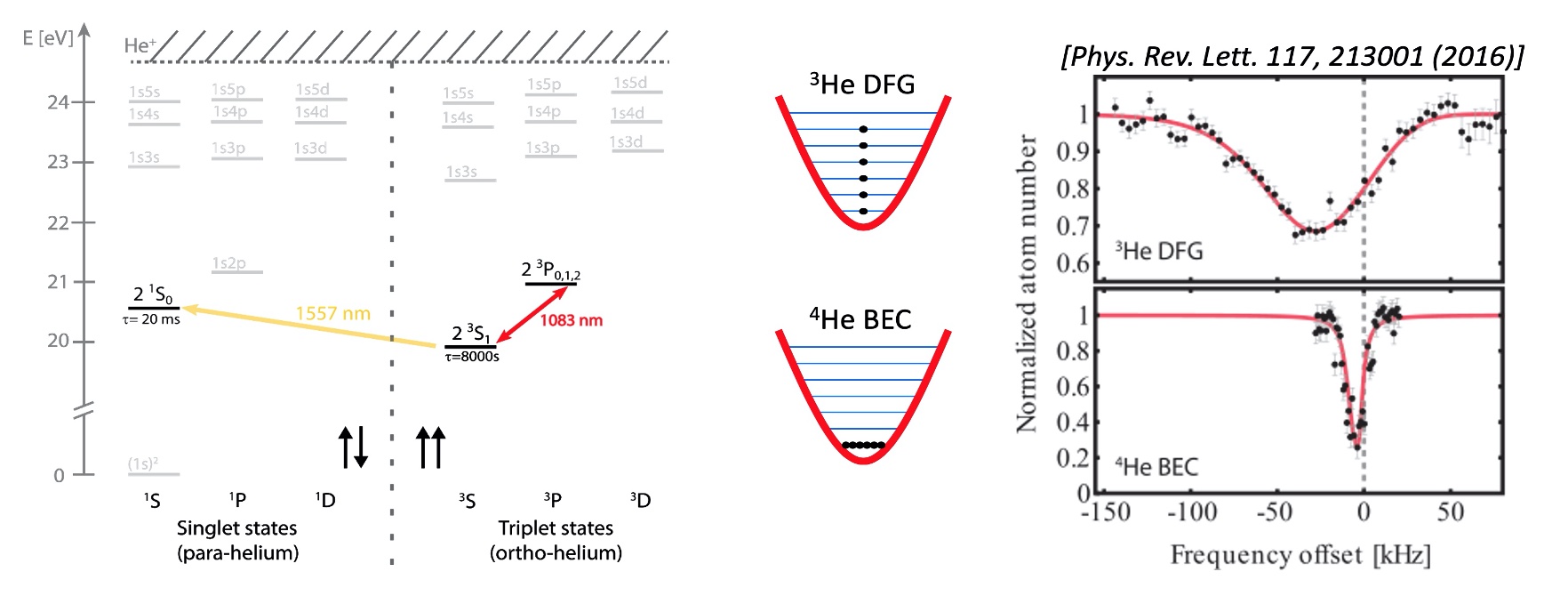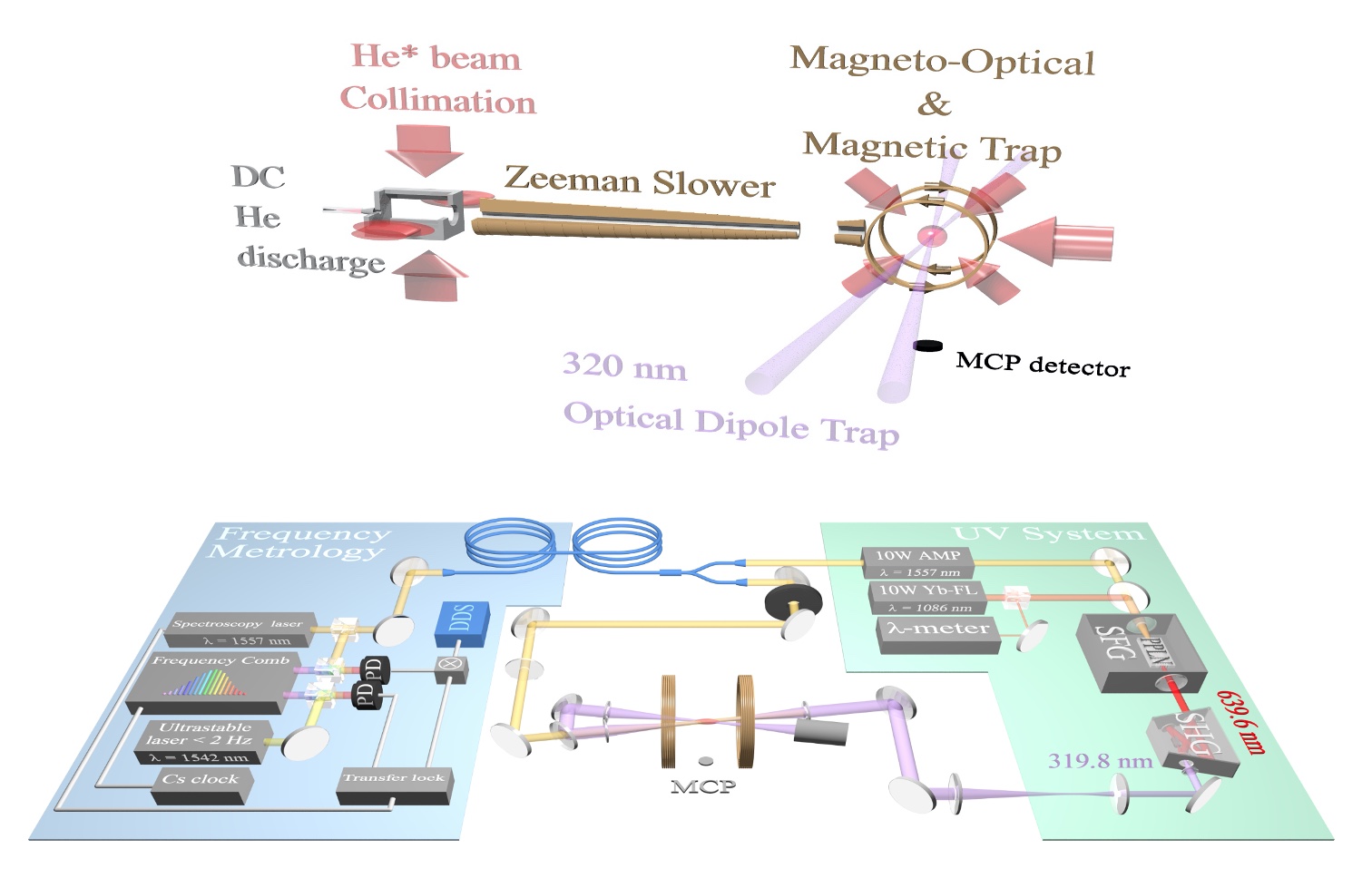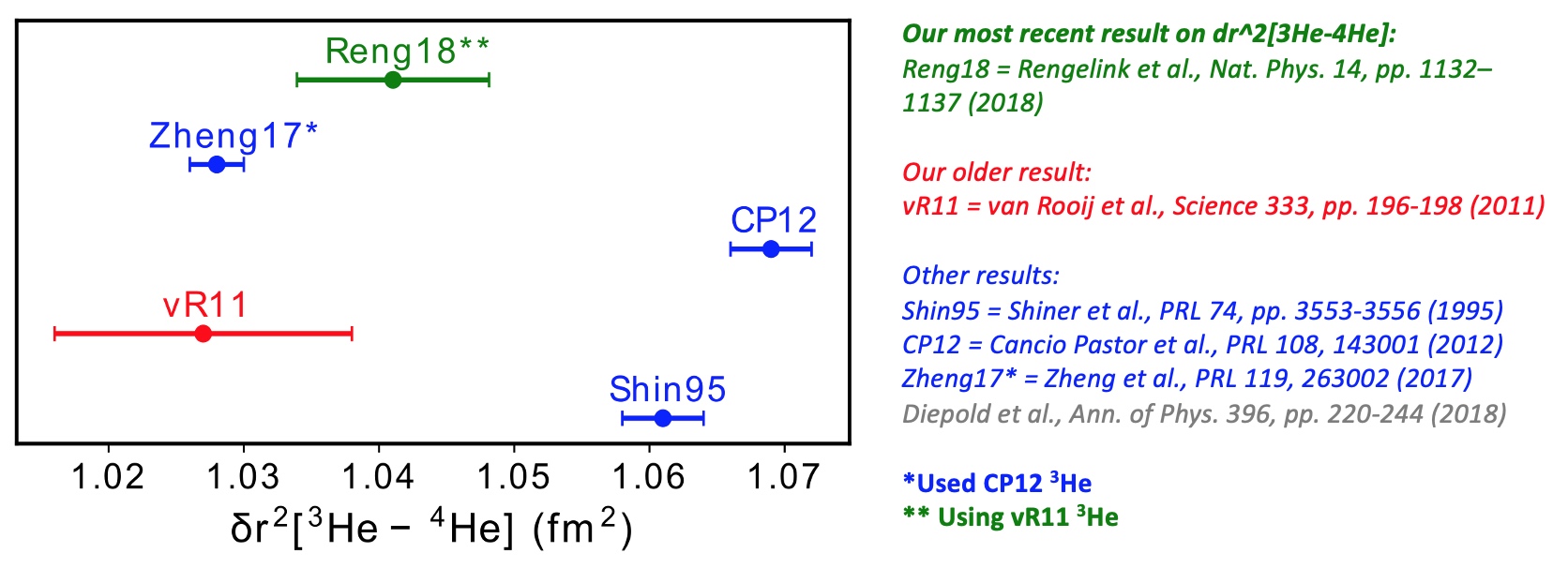Precision Spectroscopy of Quantum
Degenerate Helium
Overview
In this experiment we
are performing high-precision spectroscopy
with 3He and 4He in the quantum regime on
the 1557 nm transition (see level scheme
below). The transition starts from
meta-stable helium He*, which is helium in
the long-lived (8000s) excited '2 triplet
S_1' state. We can control He* with a
series of laser cooling techniques,
trapping in magnetic and optical fields,
and evaporative cooling. In this manner we
can cool both isotopes of helium to
quantum degeneracy, leading to a
Bose-Einstein Condensate (BEC) for 4He (a
boson), and a Degenerate Fermi Gas (DFG)
for 3He (a fermion).
The idea is to measure the difference of
the 1557 nm line in 3He and 4He very
accurately to study laser excitation in
the quantum regime, and to extract a
charge-radius squared difference between
3He and 4He. In effect we can measure the
difference between the alpha particle and
the helion particle, and this can be
compared to other measurements on other
transitions (and e.g. based on muonic
helium spectroscopy performed by the CREMA
collaboration). These measurements are
performed in a NWO research program in our
larger QML group with the aim to test the
Standard Model by precision measurements
in calculable systems, such as helium (and
systems such as He+ and H2). The
measurements also contribute to get more
insight in the 'Proton Radius Puzzle'
(based on the fact that the charge radius
of the proton measured by different means
and systems do not all agree).
Originally this research was set up and
guided by Wim Vassen. He was the expert for
meta-stable helium research in
our larger QML group, and achieved
impressive results with it (e.g.
demonstration of quantum-chaos in strong
magnetic fields, demonstration of the
Hanbury Brown-Twiss effect, BEC of 4He,
first DFG of 3He, and the results shown
below with the first measurement of the
charge radii-squared difference of 3He and
4He). Unfortunately Wim Vassen passed away
in 2019, but since then his research is
still continued. The spectroscopy
described on this page is now the
responsibility of Kjeld Eikema, and the
atom-interferometer activities is the
responsibility of Rick Bethlem, but we
collaborate on both research themes in the
spirit of the former research group of Wim
Vassen.
|

|
Above:
Yuri van der Werf (PhD student)
and Raphael Jannin (postdoc) with
the setup, May 2020. On the right
the UHV spectroscopy chamber
(before the recent technical
overhaul).
Below: On the left: the
energy level scheme of
meta-stable helium. The black
arrows indicate the two electron
spin states, leading to para
(total spin=0) and ortho (total
spin=1) states. The transition
we probe at 1557 nm is very
narrow and 'doubly forbidden'
because it goes from an S to an
S state, and the spin of one of
the electrons flips. It
therefore needs a
narrow-linewidth, high power
laser and a long interaction
time. The red 1083 nm
transition is the laser-cooling
transition. In the
middle is a symbolic
representation of ultra-cold 3He
(Fermions, that can form a
Degenerate Fermi Gas, or DFG) and
4He (Bosons, forming a
Bose-Einstein Condensate, or BEC)
in the potential of an optical
dipole trap, and on the right the
resulting spectra, which are
clearly different (this is a
previous result measured in a
far-detuned 1557 nm dipole trap).
What you see here beautifully is
the influence of quantum effects
through spin statistics. Fermions
must occupy different states in
the trap (the Pauli exclusion
principle), leading to a
broadening of the measured
transition, while Bosons can all
be in the ground state, leading to
a narrow linewidth. This had to be
studied carefully to extract the
right transition frequencies, and
from it the charge-radius squared
difference between 3He end 4He. We
now have a Magic Wavelength trap
at 320 nm, leading to much more
accurate results, see below.
|

|
|
|
Meta-stable helium
setup and new laser system details
On the right you
can see schematically the vacuum setup
for preparation of ultra-cold helium and
the spectroscopy. Below that is
the current advanced laser system
implementation, which includes a
frequency comb laser and a sub-Hz
ultra-stable laser, and a
frequency-doubled system for making the
magic wavelength of 320 nm.
The meta-stable (He*) helium is produced
by a discharge source, followed by a
laser-collimation section and a Zeeman
slower. After that the atoms slow enough
to be captured in a Magneto-Optical
trap, and then are transferred to a pure
Magentic Trap (MT). There evaporative
cooling takes place to cool down 4He,
and in the case of 3He via collisions
also 3He. The MT is overlapped with a
crossed focused laser beam at 320 nm,
the 'magic wavelength'. At this
wavelength the ac Stark shift is equal
for the two atomic states we probe with
our spectroscopy, so we can hold/trap
the atoms in this beam without affecting
the transition frequency. We then
perform spectroscopy on a BEC (4He) or
DFG (3He) with a narrow linewidth (after
transport through a fiber ~5kHz) fiber
laser that is referenced via a
transfer-lock to a frequency comb and
our Cs atomic clock.
For 4He we can detect He ions which form
after excitation (because of collisions,
Penning ionization). For 3He we look at
the loss of atoms (upon excitation to
the 2S 1S0, rapid decay to the ground
state follows, so that the atom is no
longer trapped). The amount of atoms is
measured destructively by dropping them
on an micro-channel plate (MCP) where
they are detected with near 100%
efficiency. To scan the transition the
experiment has to be repeated many
times.
|

|
Top
part: the vacuum system for
preparation of ultra-cold helium
and the spectroscopy
Bottom part: the laser systems for
cooling, trapping, and
spectroscopy.
|
|
|

|
Recent spectroscopy on
a 4He BEC in a magic wavelength trap
On the right you
see the geometry of the new magic
wavelength optical dipole trap, formed a
two focused and crossed beams at 320 nm.
Upon excitation at 1557 nm, the atoms in
the 4He BEC leave the trap and collide,
leading to ionization. This we can measure
with an Ion-MCP. The bottom MCP enables us
to measure the amount of helium atoms in
the BEC. In the middle section you see a
typical scan of the transition. Two lines
are shown, split by a magnetic field. The
transition is determined by taking the
middle of the two to cancel the effect of
the magnetic field. In the bottom part you
see the extracted transition frequencies
from this measurement. This is then used
to determine the charge radius difference
(see the next section).
An interesting aspect of our experiment is
that we could also determine the
'scattering-length', which is a nice test
of theory, and study the transition
line shape differences between 4He and 3He
as it is determined by quantum effects,
which needed careful modelling.
We ultimately aim to reach 10 Hz on the
transition, which would be 1 part in
10^13.
|
|
Helium charge
radius results
On the right you see our
latest result for the squared charge radius
difference of 3He-4He after a re-measurement of
4He in the magic wavelength ODT ('Reng18') with
~200 Hz accuracy (Nature Physics 2018).
The spectroscopy is an order of magnitude better
than our older result ('vR11',
Science 2011) using a 1557 nm ODT.
The 2018 result for the charge radius is only
slightly better than before, because the error
is dominated by the older 3He measurement.
However, we are now in the process of also
measuring 3He with 200 Hz accuracy after a big
overhaul of the setup in the past year, leading
to much more accurate results!
While doing these experiments we encountered
very interesting quantum-mechanical effects. We
are currently investigating this and are
preparing a paper about it.
Soon we expect that the CREMA collaboration
(headed by Randolf Pohl) will
publish a new measurement of the squared charge
radius difference based on muonic helium ions,
which would make an interesting comparison.
|

|
Recent papers
R.J. Rengelink, Y. van
der Werf, R.P.M.J.W. Notermans, R. Jannin, K.S.E.
Eikema, M.D. Hoogerland, W. Vassen,
Precision spectroscopy
of helium in a magnetic wavelength optical dipole
trap
Nature Physics 14, 1132
(2018)
https://www.nature.com/articles/s41567-018-0242-5
R.P.M.J.W. Notermans, R.J.
Rengelink, W. Vassen
Comparison of Spectral Linewidths for Quantum
Degenerate Bosons and Fermions
Physical Review Letters 117, 213001 (2016)
https://journals-aps-org.vu-nl.idm.oclc.org/prl/pdf/10.1103/PhysRevLett.117.213001
Erratum - Physical Review Letters 118, 069901
(2017)
https://journals.aps.org/prl/pdf/10.1103/PhysRevLett.118.069901
|
We gratefully acknowledge
financial support from the following organizations:
Questions? Contact: k.s.e.eikema@vu.nl
|











